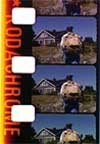 This is 8mm film This is 8mm film
|
|
|
|
"Eight millimeter" movie film was introduced in 1932 when George Eastman (Mr. Eastman Kodak) figured out how to extend the success of 16mm safety film and enroll more families in the hobby of moviemaking. 8mm film was 16mm cut in half, with 80 frames per foot, twice as many as 16mm. This made each small camera roll twice as long as 16mm in running time on the silver screen.
Please notice that 8mm holes are located at the frame line between pictures as with 16mm, but quite different from the arrangement of sprocket holes on the newer Super 8 film (Super 8 has its small holes midway in along he picture). Old 8mm is called Regular 8 in the US but Standard 8mm in the UK. The changes from 16mm to 8mm made the filmstock much more affordable, alllowing many more people to take up the hobby of moviemaking.
8mm film is safety film and is not dangerous. Some titles were sold for entertainment at home but most rolls of 8mm movie film in family hands are unique cultural documents, one of a kind records of family moments, and other things that the filmmaker was interested in. We have seen 8mm films of families, children, trips, food, parades, trains, rose gardens, and every human interest and celebration you can imagine. Please do not project your films unless you have determined they are still in good condition. Store film cool and dry. Your original film, when well stored, will last far longer than any of today's electronic media. 8mm film is still available today as double 8mm, on a small 25' daylight load roll that is turned over halfway through the exposing. Many young filmmakers love 8mm for the excellent machine age cameras they find, like the venerable Bell and Howell or Bolex 8mm cameras. 9.5mm| 16mm| 8mm | Super 8 | LittleFilm.org Home |
This information is a public service of
LittleFilm.org
Copyright © 1978 - 2011 Antoinette Treadway,IC8: International Center for 8mm Film, Inc. All rights reserved.
In 1983, Toni Treadway and Bob Brodsky founded IC8 in 1983 for information and training in Little Film making.
It is dedicated to 8mm film and its filmmakers.
IC8, The International Center for 8mm Film, Inc. is a 501c3 educational organization. Donations are welcome. Please contact us.
Write us at P.O. Box 335 Rowley, MA 01969 USA
Telephone: 978.948.7985 Please call from 9-6 EST.
Before you email a question to the editor Ms. Treadway, we ask that you search the website.
Your patience is requested. Technical questions are complicated to answer and require time she does not have. We prefer the telephone.
Must you Email? Please remove the word NOSPAM and standardize the form of the address to contact us....... TreadwayNOSPAM at LittleFilm dot org. Please give us the best time and phone to reach you. Thank you.